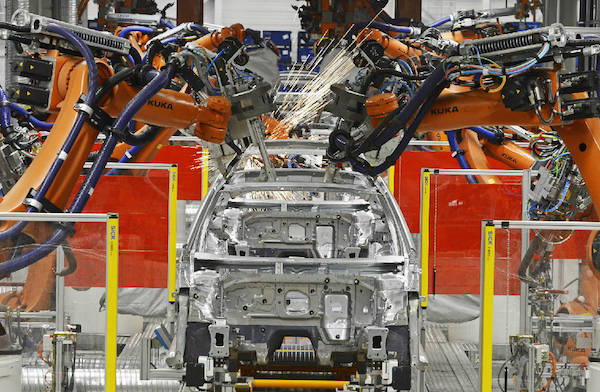The WEF has a prediction that should get people’s attention because of the rapid entry of smart machines into the workplace. According to the experts, the world of employment is about to experience a revolution because of computers, robots and automation, and humans will find themselves priced out by machines that are cheaper and don’t require lunch breaks.
See the full report here: The Future of Jobs Report 2018.
The report says that millions of new jobs will be created to replace the ones lost, so not to worry, except that those new jobs will require technical training. Retraining employees is not a chore that many American businesses have been willing to do in the past, so the transition looks to be rocky.
Plus it’s hard to take seriously the assertion that there will be more jobs created than lost: the whole point of automation is for business to save money by getting rid of expensive human workers.
Robots have largely replaced humans in automotive manufacturing.

In addition, with a rapid switch to automation being upon us, it’s crazy to continues admitting any immigrants at all, right?
Report: Machines to handle over half workplace tasks by 2025, Associated Press, Sep. 17, 2018
GENEVA (AP) — More than half of all workplace tasks will be carried out by machines by 2025, organizers of the Davos economic forum said in a report released Monday that highlights the speed with which the labor market will change in coming years.
The World Economic Forum estimates that machines will be responsible for 52 percent of the division of labor as share of hours within seven years, up from just 29 percent today. By 2022, the report says, roughly 75 million jobs worldwide will be lost, but that could be more than offset by the creation of 133 million new jobs.
A major challenge, however, will be training and re-training employees for that new world of work.
“By 2025, the majority of workplace tasks in existence today will be performed by machines or algorithms. At the same time a greater number of new jobs will be created,” said Saadia Zahidi, a WEF board member. “Our research suggests that neither businesses nor governments have fully grasped the size of this key challenge of the Fourth Industrial Revolution.”
The “Future of Jobs 2018” report, the second of its kind, is based on a survey of executives representing 15 million employees in 20 economies. Its authors say the outlook for job creation has become more positive since the last report in 2016 because businesses have a better sense of the opportunities made possible by technology.
The WEF said challenges for employers include enabling remote work, building safety nets to protect workers, and providing reskilling for employees. However, the report found that only one in three respondents planned to reskill at-risk workers.
Despite net positive job growth, the WEF anticipates a “significant shift in the quality, location, format and permanency of new roles. Businesses are to expand use of contractors for task-specialized work, engage workers in more flexible arrangements, utilize remote staffing, and change up locations to get access to the right talent.
The report said nearly half of all companies expect their full-time workforces to shrink by 2022, while nearly two in five expect to extend their workforce generally, and over one-quarter expect automation to create new roles in their enterprises. (Continues)